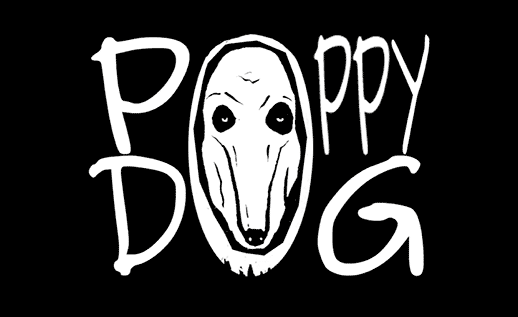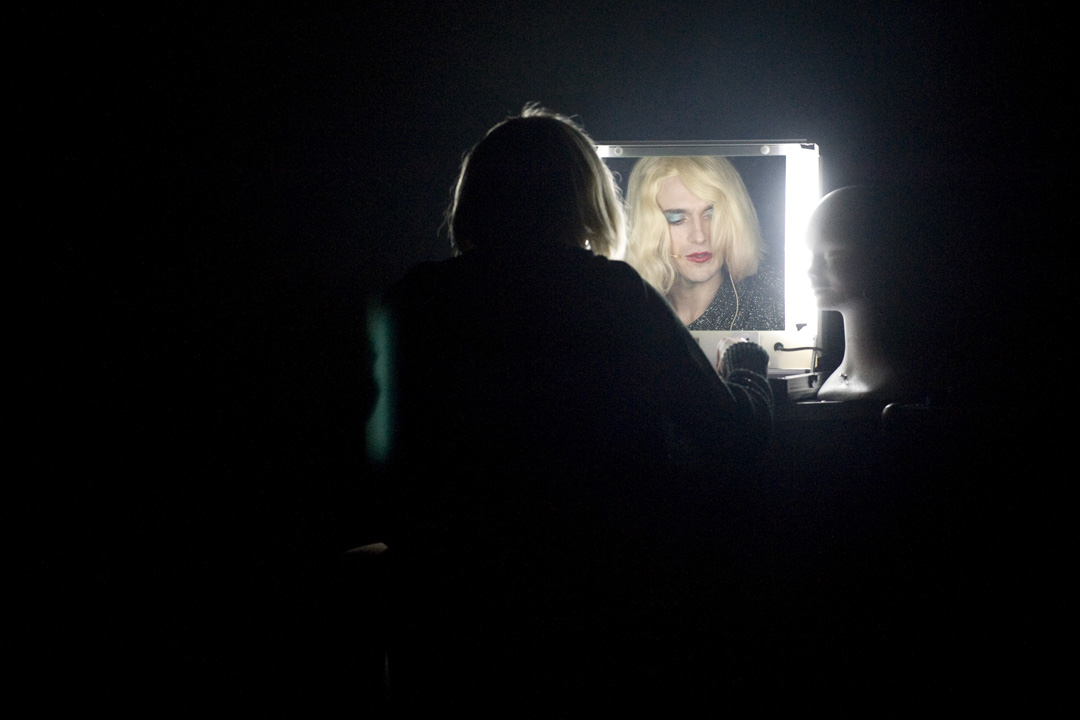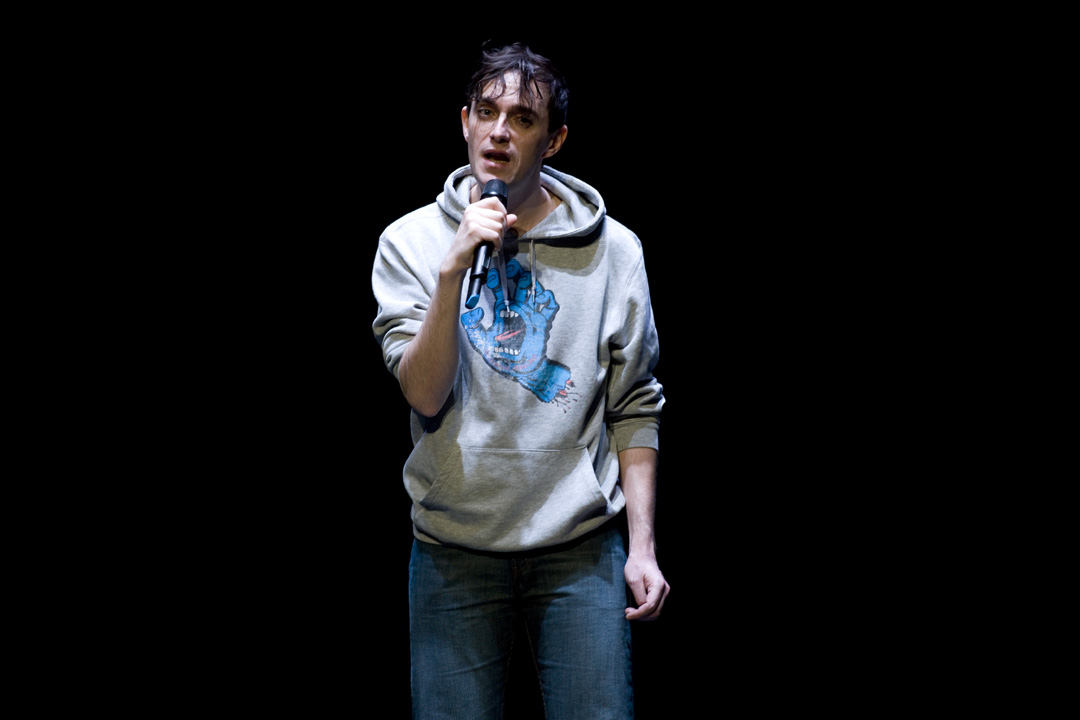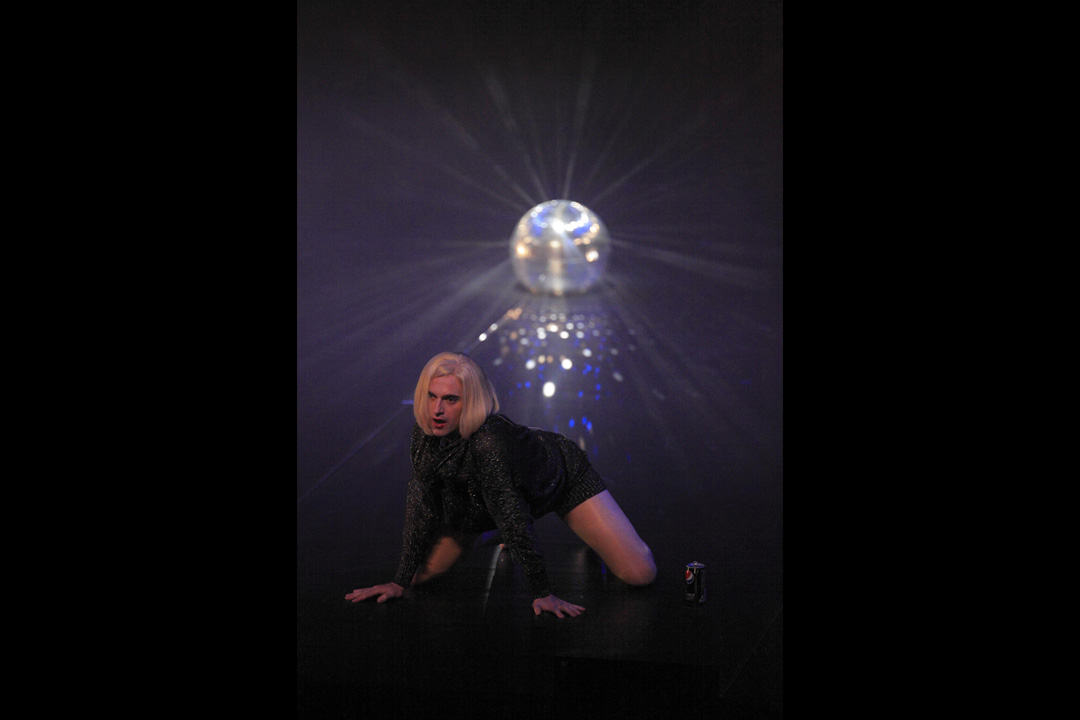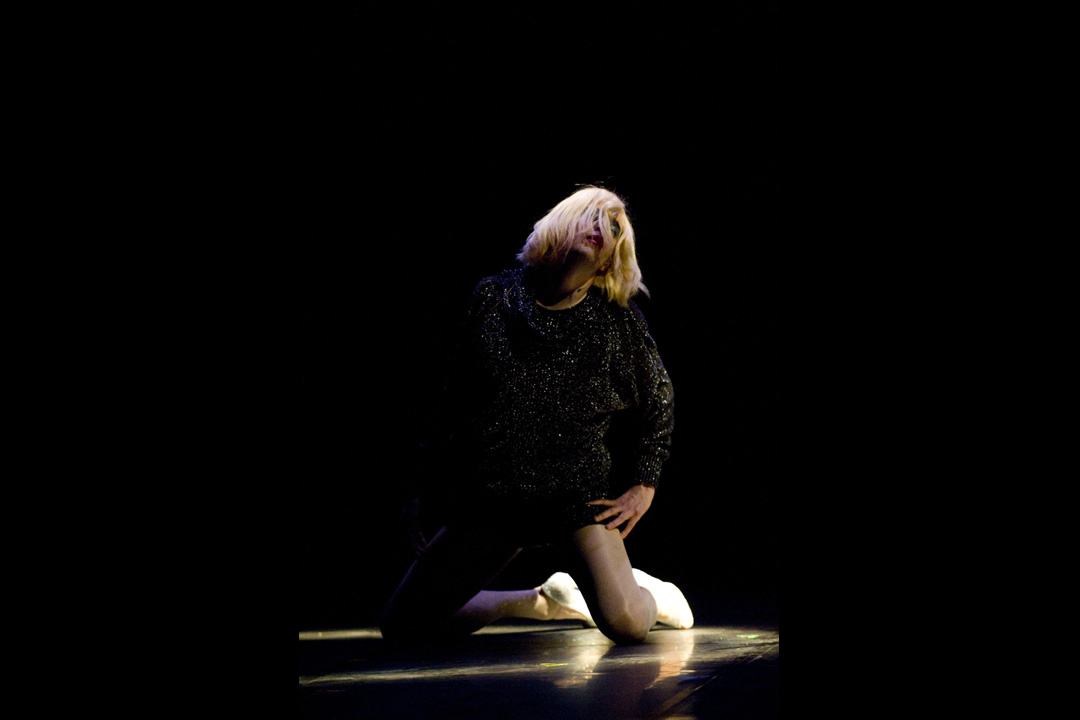ADISHATZ / ADIEU
Conception and performing
Jonathan Capdevielle
Creation november 2009, CCN de Montpellier
CAST
Jonathan Capdevielle
LIGHT Patrick Riou
STAGE MANAGER Christophe Le Bris
SOUND MANAGER Johann Loiseau
ARTISTIC COLLABORATION Gisèle Vienne
ARTISTIC CONSULTANT Mark Tompkins
AUDIO ASSISTANCE Peter Rehberg
TOURING ARTISTIC ASSISTANT Jonathan Drillet
ADMINISTRATION AND TOURING
Fabrik Cassiopée – Manon Crochemore, Manon Joly et Isabelle Morel
WITH THE PARTICIPATION OF
ECUME, university choral group of Montpellier – Musical direction : Sylvie Golgevit – with Pierre-Yves Bruzzone, Renaud Lebrun, Paco Lefort, Jean-Luc Martineau, Olivier Strauss, Benoit Vuillon.
THANKS TO
Aurélien Richard, Mathieu Grenier, Tibo Javoy et Ya Basta, for recording and mix of chorus on “pitaladyfacegalaxymix”, Jean-Louis Badet, and Barbara Watson, Henry Pillsbury.
WITH THE HELP OF
DACM and the technical staff of Quartz, Scène Nationale de Brest
PRODUCTION
Bureau Cassiopee was the executive producer of Adishatz / Adieu until january 2016:
Production Anne-Cécile Sibué-Birkeland. Booking / administration Léonor Baudoin et Manon Crochemore
coproduction Centre Chorégraphique National de Montpellier Languedoc Roussillon dans le cadre de ]domaines[ (FR), Centre Chorégraphique National de Franche-Comté à Belfort dans le cadre de l’accueil-studio (FR) and BIT Teatergarasjen, Bergen (NO).
with the support of Centre national de la Danse (FR) for the studio during rehearsals.
PAST TOUR
January 2010 Festival « C’est de la danse contemporaine 2010 », CDC – Toulouse (F)
March 2010 Festival Antipodes, Le Quartz – Scène Nationale de Brest (F)
Juillet 2010 Festival d’Avignon, la vingt cinquième heure (F)
January 2011 Le Parvis, Tarbes (F)
January 2011 BIT Teatergarasjen–Bergen (NO)
February 2011 Festival Antigel / ADC – Genève (CH)
March 2011 Centre Pompidou, dans le cadre du Nouveau Festival – Paris (FR)
March 2011 Festival Ardanthé, Théâtre de Vanves Scène Conventionnée pour la Danse (FR)
April 2011 Danae Festival (IT)
April 2011 Festival TUPP, Uppsala stadsteater – Uppsala (SE)
May 2011 Maison des Arts de Créteil (FR)
October 2011 Théâtre Cai / Institut Français de Tokyo, dans le cadre de Festival/Tokyo – Tokyo (JP)
November 2011 Kyoto (JP)
January 2012 Pôle Sud, en coréalisation avec le Maillon – Strasbourg (FR)
March 2012 CIRCUITS Scène conventionnée Auch – Gers- Midi Pyrénées
March 2012 Espace Jéliote, Oloron-Sainte-Marie
April 2012 L’Usine C – Montreal (CA)
April 2012 Festival [à corps], Scène Nationale de Poitiers (FR)
Juillet 2012 Festival Rayon Frais – Tours (FR)
September 2012 Short Theatre Festival, Rome (IT)
September 2012 Contemporanea Festival, Prato (IT)
October 2012 Actoral, Marseille (FR)
October 2012 C’est comme ça, le festival de L’échangeur, CDC Picardie, Fère-en-Tardenois (FR)
January 2013 Santiago a mil – International Festival, Santiago del Chili (CL)
March 2013 festival Via-focus théâtre, Le Manège, Maubeuge-Mons (FR)
April 2013 Scène Nationale d’Orléans (FR)
May 2013 CNDC Angers, Le quai forum des arts vivants, Angers (FR)
May 2013 L’Arsenic Lausanne (CH)
June 2013 Pronomades en Haute-Garonne, Centre national des Arts de la rue (FR)
August 2013 Festival d’Aurillac (FR)
January 2014 Théâtre d’Arras, scène conventionnée musique et théâtre (FR)
January 2014 Théâtre des Salins, scène nationale de Martigues (FR)
April 2014 Théâtre de la Vignette, Montpellier (FR) en collaboration avec l’ONDA, Réseau en scène Languedoc-Roussillon et l’IETM
May 2014 SPRING Performing Arts Festival – Utrecht (NL)
October 2014 Dublin Theater Festival (IRL)
November 2014 Le Manège de Reims, Scène nationale (FR)
November 2014 Théâtre de Clermont L’Hérault (FR)
January 2015 Festival Tendance Europe, Maison de la culture d’Amiens, centre européen de création et de production (FR)
January 2015 Festival Vivat La Danse, Le Vivat, scène conventionnée danse et théâtre, d’Armentières (FR)
September 2015 Bitef festival – Belgrade (RS)
October 2015 Festival 4+4 Days in Motion – Prague (CZ)
December 2015 Nouveau Théâtre de Montreuil, CDN (FR)
January 2016 Coil, PS122 – New York (US)
April 2016 Le Carré Les Colonnes – Saint Médard en Jalles (FR)
September 2016 Culturegest, Gestao de Espaços Culturais – Lisbonne (FR)
October 2016 Les deux scènes, scène nationale de Besançon (FR)
November 2016 Théâtre Les Halles – Sierres (CH)
December 2016 Le Quai CDN Angers Pays de la Loire (FR)
January 2017 Théâtre Garonne, scène européenne – Toulouse (FR)
October 2017 Théâtre du Bois de l’Aune – Aix-en-Provence (FR)
December 2017 Théâtre du Rond Point – Paris (FR)
January 2018 Théâtre du Rond Point – Paris (FR)
January 2018 POC d’Alfortville (FR)
June 2018 Naves Matadero, Centro Internacional des artes vivas – Madrid (ES)
September 2018 Black Box Teater, Oslo (NOR)
Background visual : © Toshihiro Shimizu, design : Grégoire Gitton
Through the genre of autofiction – a type of confession documentary – Adishatz/Adieu tells the story of a character that sways between real life and a world of dream or fantasy. The piece is created from songs, conversations that allude to roots or family as a journal would.
The songs are a means of expression for the boy, they first act as a musical and rhythmic structure but they gradually reveal the character’s obsessions, emotions and a certain nostalgia that slowly spreads to the audience. Sung a capella they immediately show the character’s vulnerability and authenticity. The absence of accompaniment puts the focus on the lyrics that resonate as a proper language. Some songs are translated from English to French and are twisted, repeated, modified, sometimes both words and music are sung, or different genres are mixed (from Madonna to French singer Francis Cabrel).
Adishatz/Adieu resorts to the technique of imitation often used to entertain. Here it is distorted with a blurry force. It is important to multiply contrasts, to arrange different means of vocal expression, to allude to diverse identities, to confuse the audience using humor and solemnity among other things as tools for detachment.
The aim is to shine light on the path walked as one attempts to grasp “someone else” as well as to reveal the tools used to reach an authenticity or even to fail trying. It applies both to famous people and to close relatives, family and friends. It is also about physically reproducing videoclips postures and to take pop culture codes over with a view to authenticity. The moving body sometimes split with the words and makes room for the voice of other characters drawn from memory.
At one point a men’s chorus appears onstage. By choosing to sing folk songs with them, the character emphasizes popular stereotypes from the Southwest of France as well as alludes to roots and tradition. Pop culture, Tarbes city culture as well as clubbing are part of the character’s obsessions and history. In the piece he explores the curious mix between local and international culture. The character experiences different attitudes that touch on vulnerability, adolescence or masculinity. He is a mixed figure that sways between grace and rudeness. Dressing up emphasizes a certain idea about loneliness while conjuring up something delicate and sensible. Dressing up is shared by men and women and can be used by both sexes. Eeriness and trouble enable every turnaround and diversion. Loneliness is tangible: it is sad and melancholic but never tragic.
With the piece I worked on the nostalgia of things, to conjure up the identity making memory: childhood or adolescence, nostalgia of yesterday’s hits that left their mark on my life and still resonates today…
Jonathan Capdevielle
